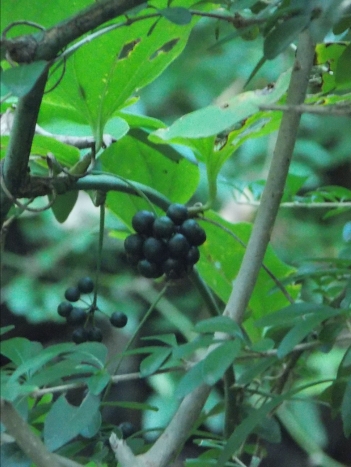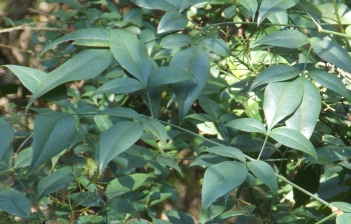Greenbriar; Saw Greenbriar/Cat-Claw Briar Smilax bona-nox L.;. This brittle, stout, green, spiny, climbing vine sprouts from thick, knobby tubers barely under the ground, which are joined by thick rhizomes. Lower parts of the vine are ¼” thick, and tough, but snap easily. The green thorns are not recurved, but are flattened (like rose thorns) and stout, up to ¼” long, often with a black tip. Vines easily grow 30′ to 50′ long, the upper ends branching easily, forming tangles in trees. New leaves may be lobed, and are often mottled with purple, and have thorn like teeth along their margins, but older leaves are green, tend to be heart-shaped and crisp, alternating around the stem. New shoots are tender and can be eaten raw or grilled, like asparagus. Abundant in thin soils over chalky limestone, in forests they climb into surrounding trees with climbing tendrils, but in the open they may form a bramble. Umbels of small white flowers bud from the axils of new leaves on a long peduncle, each bunch of 5 petal flowers transforming into a cluster of black berries. Spanish speakers grilled the new shoots, calling them zarza parilla, “grilled bramble”, and ground the tubers, soaking the mash to produce a spicy concoction. English speakers transphonologized the Spanish as “sarsaparilla” [sasparila]. (72-73) 4/11/15 – 5/4/15; 4/1/16; 4/15/17; 4/6/18; 19 no obs; (new shoots 3/15/20) 4/10/20;

Saw Greenbriar habit; a stout, woody vine growing from knobby tubers, with sharp flattened thorns, often tipped in black, climbing by means of tendrils.

Note; Catclaw, or Saw Greenbriar grows from a hard, fibrous, knobby tuber

Note; young leaves may be heart shaped, or lobed, alternating in a spiral, often with a saw tooth margin

Note; some new leaves are maroon, mottled with green

Note; umbels of tiny, white, 5 petal flowers bud from leaf axils, converting to black berries

Note; umbels of small, green flowers convert to clusters of juicy, black, fall berries






























